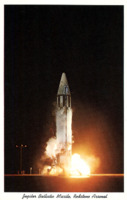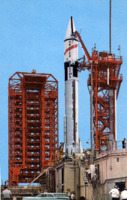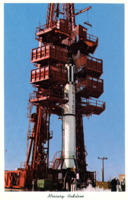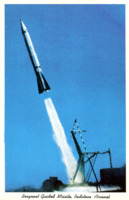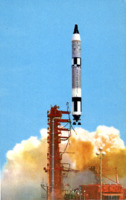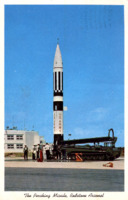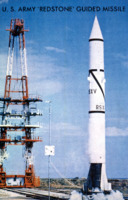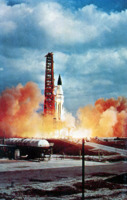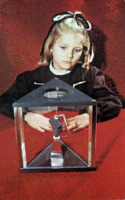
Browse Items (490 total)
Sort by:
-
Jupiter Ballistic Missile
Front: Jupiter Ballistic Missile, Redstone Arsenal
Back: JUPITER BALLISTIC MISSILE, REDSTONE ARSENAL, HUNTSVILLE, ALABAMA
The largest weapon, for which the Army has development responsibility, the Jupiter has pin-point accuracy against targets at ranges up to 1,500 nautical miles. The missile is 58 feet in length, and 105 inches in diameter. -
Centaur II undergoes pre-launch tests
Back: Centaur II, our first space vehicle to use liquid hydrogen as a propellent, undergoes pre-launch tests.
The NASA Marshall Space Flight Center at Huntsville, Alabama, has been developing and providing rockets for our space achievements since the very beginning of our entry into this field. -
Mercury Redstone
Front: Mercury Redstone
Back: National Aeronautics and Space Administration's "Mercury-Redstone" being readied for launch at the Cape Kennedy launch site. The rocket was provided by the NASA George C. Marshall Space Flight Center, Huntsville, Alabama. -
Sergeant Guided Missile
Front: Sergeant Guided Missile, Redstone Arsenal.
Back: SERGEANT GUIDED MISSILE, REDSTONE ARSENAL, HUNTSVILLE, ALABAMA.
Measuring about 30 feet in length, the Army's Sergeant is a surface-to-surface, solid propellant, ballistic guided missile possessing a very high degree of reliability and accuracy. Also highly mobile, it can be quickly emplaced and fired by a very small crew, under all conditions of weather and terrain, delivering a nuclear blow far behind enomy lines. Its highly accurate guidance system is invulnerable to any known means of enemy counter-measures. -
Gemini - Titan I Lifting Off Launching Pad
Back: Gemini-Titan 1 lifting off launching pad on its maiden voyage, testing spacecraft and vehicle. The Gemini is the first of NASA's two-man spacecrafts. The NASA Marshall Space Flight Center at Huntsville, Alabama, has been developing and providing rockets for our space achievements since the very beginning of our entry into this field. -
The Pershing Missile
Front: The Pershing Missile, Redstone Arsenal
Back: THE PERSHING MISSILE, REDSTONE ARSENAL, HUNTSVILLE, ALABAMA
This Pershing surface to surface missile can deliver an atomic warhead deep into enemy territory. The Army missile is a solid propellant ballistic missile under development by the Army Ballistic Missile Agency to replace the old reliable Redstone. The missile is named for General of the Armies John J. Pershing, World War I hero. -
U.S. Army Redstone Guided Missile
Front: U. S. Army 'Redstone' Guided Missile
Back: U. S. Army 'Redstone' Guided Missile
Huntsville, Alabama, Home of Army Ballistics Missile Agency. Named after Redstone Arsenal, the Redstone is the Army's largest surface-to-surface guided missile. Capable of carrying a nuclear warhead, this weapon has proven to be very accurate at supersonic speeds. This photo is actual color made by U. S. Army. -
Saturn I Space Vehicle
Back: A Saturn I space vehicle, developed by the National Aeronautics and Space Administration's Marshall Space Flight Center. Huntsville, Ala., is launched from Cape Kennedy, Fla. The Saturn I weighs more than a million pounds at liftoff, and generates a maximum of 32,000,000 horsepower. It is a fore-runner of the Saturn V moon rocket being developed by MSFC. Huntsville. -
Alabama Space and Rocket Center
Back: ALABAMA SPACE AND ROCKET CENTER, Earth's Largest Space Exhibit. Tranquility Base, Huntsville. Alabama 35807.
This moon rock sample is displayed at Earth's largest space exhibit. It was collected on the moon by Apollo II astronauts. It is believed to be over 3 billion years old, and weighs 4.9 ounces. -
Redstone Missile
Front: Redstone
Back: Redstone Missile. Developed at Huntsville, Alabama's Redstone Arsenal, the Redstone is shown here being readied for launching at Cape Canaveral.
